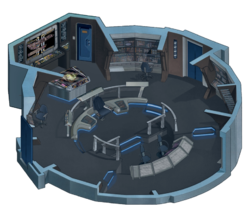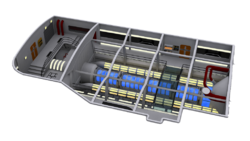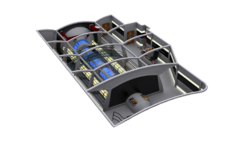DujlIj Hegh

| |
| DujlIj Hegh (Ship of the Dead) | |
| Class Information | |
| Role: |
Light Cruiser |
| Decks: |
10 |
| Cruising Speed: |
Warp 7 |
| Personnel | |
| Total Compliment: |
60 |
| Tactical Systems | |
| Energy Weapons: |
3x Type-X Phaser Arrays |
| Torpedo Launchers: |
|
| Shields: |
Symmetrical Subspace Graviton Field. |
| Template:Shipclass | |
Contents
DujlIj Hegh (Ship of the Dead)
Ship History
Coming Soon!
Integrated Technology
Coming Soon!
Senior Crew
- Ship's Captain: Kelinor Voseh
- First Mate:
- Head of Security:
- Head of Engineering:
- Head of Operations:
- Head of Science:
- Ship's Doctor:
- Ship's Pilot:
These are the technical specifications for the Saber-Class pirate ship DujlIj Hegh.
General Information and Layout
The Saber Class starship entered service for Starfleet in 2358 with the purpose to replace the out-dated Oberth class science and scout ships, as well as to fill the role of an escort or police vessel for the internal security of the Federation. With limited facilities, long-term missions were generally outside of its design, but for internal Federation missions, or specific deep space objectives, the Saber proved to be a very capable ship.
Small, fast, highly maneuverable, and well armed, the Saber has also proven its worth as a defensive vessel. Many ships of this class were involved in the defense of Sol during the Second Borg Incursion, as well as being involved in the conflict against the Cardassian/Dominion alliance. While not specifically a warship, the Saber held its own and showed itself to be a valuable asset for Starfleet and the Federation.
Since the commissioning in 2356, the Saber-class has been prolific. While not glamorous, the small vessel completes its assigned tasks with great proficiency, and trustworthiness. During its flight career it has logged some of the fewest engineering problems, and some of the best warp field efficiencies within Starfleet. Even when its compatriot, the Steamrunner class, was pushed out of its field by the newer Intrepid class, the Saber continued to serve in Starfleet.
Even though safety was always a concern, it wasn't until the discovery of the Dominion that Starfleet began to consider strengthening the Saber. With the Steamrunner entering into a refit cycle, it was decided that certain variations of the Saber would also be upgraded to stronger offensive/defensive capabilities. Patrol and Scout variants were redesigned to handle the 2nd generation torpedo launchers and the new Type X phaser arrays. New shield grids and avionics upgrades were included as well as general engineering redesigns and computer core replacements. When completed, the 'new' Saber class, designated FFU, became a formable defensive platform.
The FFU-P Designation (Fast Frigate Uprated-Patrol)
Tactical/Defensive Operations: The FF/FFU-P is a Patrol ship, with the main purpose of guarding borders and patrolling shipping lanes. It has decreased scientific and diplomatic facilities to allow room for increased torpedo storage, additional security personnel, additional shield generators, and improved tactical sensors and communication equipment.
Crew
The DujlIj Hegh currently holds 35 of the maximum crew of 60. The ship has the capacity to support up to 500 evacuees with conversion of the Flight Decks and Cargo Bay to emergency living quarters.
Measurements
- Length: 190 meters
- Beam: 193.19 meters
- Height: 48.60 meters
- Mass: 2,756,000 metric tons
- Number of Decks: 10
Deck Layout
- Deck 1: Main Bridge, Captain's Ready Room, Conference Room, Stellar Cartography, Main Engineering (upper), Chief Engineer's Office, Aft Torpedo Launcher
- Deck 2: Officer's (Senior Staff) Quarters, VIP Quarters, First Mate's Office, Main Engineering (Lower), Warp Core, Fore and Aft Torpedo/Probe Magazines, Computer Core and Control Room, Captain's Mess
- Deck 3: Crew Quarters, Diplomatic Facilities (decreased to allow room for increased torpedo storage, improved tactical sensors, and shield generators per Tactical/Defensive Operations of FFU-P Variant), Transporter Rooms 1 & 2, Mess Hall, Forward Torpedo Launcher, Computer Core
- Deck 4: Sickbay, Chief Doctor's Office, Science Labs 1 - 8 (Labs 5-8 decreased to allow additional security personnel, communications equipment, and shield generators per Tactical/Defensive Operations of FFU-P Variant), Science Chief's Office, Hydroponics bay, Shuttlebay 1, Pilot's Office
- Deck 5: Lounge, Holosuites, Gymnasium, Security Chief's office, Security Dept/Brig, Ship's Armory, Phaser Range, Shuttle Bay 2, Shuttle Maintenance, Docking Ports
- Deck 6: Cargo Bay 1, Cargo Transporter 1, Aux. Weapon Controls
- Deck 7: Deuterium Storage, Anti-Matter Storage Pods, Life Support Systems
- Deck 8: Navigation Deflector Control room, Long-Range Sensors (LRS) Control room, Navigational Deflector
- Deck 9: Navigational Deflector, LRS
- Deck 10: Waste Processing/Recycling Center, Life Support
Propulsion Systems
- Sublight Speed: 0.50c
- Maximum Sublight Speed: 0.75c
- Cruise: Warp 7
- Maximum: Warp 9
- Emergency: Warp 9.8 for 12 hours
Warp Drive
The warp core is located in the engineering section and lies horizontally on deck 2. The matter-antimatter reaction assembly (M/ARA) is embedded within Deck 2, with the surrounding systems on the balcony above (Deck 1, Main Engineering). The core is constructed from a central translucent aluminum and duranium reactor with dilithium articulation frame, four-lobed magnetic constriction segment columns, and matter and antimatter injectors. Plasma transfer conduits exit the core on Deck 2 and extend laterally to the nacelles and the warp plasma injectors. The nacelles incorporate an in-line impulse system, which accepts matter intake and heating within the nacelles and exhausts the heated gases through a space-time driver assembly in the nacelle aft cap. Anti-deuterium is stored in a series of standard Starfleet antimatter pods on Deck 7, aft of the warp core.
The warp field coils, unlike most Federation ships, are located just within the main hull as opposed to outboard nacelles. The basic structure of the nacelles is similar to that of the remainder of the starship, however, the entire length of the nacelle housing is augmented with longitudinal stiffeners composed of cobalt cortenide to protect against high levels of warp-induced stress. Throughout the nacelle housing are triply redundant conduits for Structural Integrity Field (SIF) and Internal Damping Field (IDF) systems. Each nacelle contains a pair of four warp field coils, making Saber-class vessels have a total of 16. The B-grade warp reactor is extremely powerful for a ship of this size, and as such, the Saber-class vessels put out a warp signature equivalent to much larger starships. Advances in variable warp field geometry ensures that all ships of this class will not cause harmful subspace damage. All regulation warp engine controls and procedures apply to Saber-class vessels.
In the event of a possible warp core breach, the main M/ARA core can be ejected out of the rear of the ship.
Impulse Drive
The sublight, or impulse drive is the standard Saber-Class mass-drivers developed and built by HighMPact Propulsion. Their output is comparable to that of the New Orleans-Class starship. Each of the Saber-Classes two impulse engines can individually propel the ship at speeds just under 0.50c. 'Maximum Impulse' is 0.75c and requires both engines working at approximately 3/4 strength. Due to time dilation problems, standard impulse operations are limited to 0.25c ('Full Impulse'). 'Half Impulse' is 0.125c, while '1/4 impulse' is 0.0625c.
RCS Thrusters
The Reaction Control System (RCS) thrusters are adapted from thruster packages found on the New Orleans-class vessels. A total of eight thruster groups are installed; two are placed in the forward hull, four in the mid-hull, and two in the aft cowling. Deuterium is supplied by the primary tank on Deck 7 and immediate-use tanks within thruster packages. Each thruster quad is capable of producing 4.2 million Newtons of exhaust.
Tactical Systems
Defensive Systems
The Saber-Class has a Symmetrical Subspace Graviton Field. This type of shield is fairly similar to those of most other Starships. During combat, the shield sends data on what type of weapon is being used on it, and what frequency and phase the weapon uses. Once this is analyzed by the tactical officer, the shield can be configured to have the same frequency as the incoming weapon - but different nutation. This tactic dramatically increases shield efficiency.
There are a total of eight shield generators on a Saber as a standard. The FFU-Patrol Variant allows for four more shield generators; two in converted Diplomatic Facilities and two in converted Science Labs. This brings the total to twelve shield generators. Each generator consists of a cluster of ten 28 MW (megawatt) graviton polarity sources feeding into a 575 millicochrane subspace field distortion amplifier. Each generator produces 280 MW of shield power, and each can approach 98,000 MW for 150 nanoseconds during peak momentary loads.
During Red Alert situations, five of the generators will operate in a phase lock, producing a continuous output of about 1400 MW. In the Patrol Variant, nine of the twelve will operate in phase lock. Non-essential areas and functions are shutdown and their power re-routed when the other four generators are brought online.
During Cruise Mode, two generators are required to be operational at all times with one additional generator on standby. Deflector output during Cruise mode is approximately 560 MW.
The power for the shields is taken directly from the warp engines and impulse fusion generators. If desired, the shields can be augmented by power from the impulse power plants. The shields can protect against approximately 23% of the total EM spectrum (similar to a Galaxy Class Starship's shields).
The shields, when raised, stay extremely close to the hull to conserve energy. The average range is seven meters away from the hull, but that can be extended to surround a nearby object, though at the loss of shield strength.
Offensive Systems
Phasers
- 2x Type-X (Dorsal)
- 1x Type-X (Ventral)
The Saber-Class Patrol Variant has two dorsal phaser arrays on the primary hull, extending from the aft 1/3 of the saucer and converging on either sides of the bridge. Ther is one ventral phaser array with a 90 degree arc on the forward half of the primary hull. Originally the Saber-class vessel was launched with three type IX phaser arrays. After the fleet wide refit, the Saber-class, even though it is a small sized vessel, was fitted with the Type X array system, the new standard in phaser emitters.
Each array fires a steady beam of phaser energy and the forced-focus emitters discharge the phasers at speeds approaching .986c. The phaser array automatically rotates phaser frequency and attempts to lock onto the frequency and phase of a threat vehicle's shields for shield penetration.
Each phaser array takes its energy directly from the impulse drive and auxiliary fusion generators. Individually, each type X -emitter can only discharge approximately 5.1 MW (megawatts). However, several emitters (usually two) fire at once in the array during standard firing procedures, resulting in a discharge approximately 10.2 MW. The maximum effective range is 300,000 kilometers.
Torpedoes
- 1 Forward Launcher (3 tube)
- 1 Aft Launcher (3 tube)
- Payload
- 45 Photon Torpedoes
The Saber-Class has two fixed-focus torpedo launchers that are used for photon or quantum torpedies and science probe deployment. The forward launcher is located on deck three and the aft launcher is located on Deck one. In the uprated Saber, these launchers are the second generation of automated, high-speed launcher found on the smaller, newer starships (such as the Intrepid, Defiant and the Nova) and each is capable of firing 3 devices at a time, giving the ship a salvo of 6 torpedoes at a time (3 forward, 3 aft).
The standard type carried is a Mark XXV photon torpedo. This torpedo is capable of pattern firing (sierra, etc.), independent launch, independent targeting once launched from the ship, and detonation on contact unless otherwise directed by tactical. Sabers can carry 45 completed torpedoes. Additional components stored onboard can allow for the manufacture of an additional 15 photon torpedoes. The standard manufacture rate is 2 torpedoes per hour and the Max rate is 5 torpedoes per hour. The maximum effective range is 3,000,000 kilometers.
Sensor Systems
Long-range and navigation sensors are located behind the main deflector dish, to avoid sensor "ghosts" and other detrimental effects consistent with main deflector dish millicochrane static field output. Long Range Sensor (LRS) controls are located on deck 8. Lateral sensor pallets (Short Range Sensors) are located around the rim of the entire Starship, providing full coverage in all standard scientific fields, but with emphasis in the following areas:
- Astronomical phenomena
- Planetary analysis
- Remote life-form analysis
- EM scanning
- Passive neutrino scanning
- Parametric subspace field stress (a scan to search for cloaked ships)
- Thermal variances
- Quasi-stellar material
Each sensor pallet (sixteen in all) can be interchanged and re-calibrated with any other pallet on the ship. Warp Current sensor: This is an independent subspace graviton field-current scanner, allowing Saber class vessels to track ships at high warp by locking onto the eddy currents from the threat ship's warp field, then follow the currents by using multi-model image mapping.
Long- and Short-Range Sensors
There are eighteen independent tactical sensors on a Saber. Each sensor automatically tracks and locks onto incoming hostile vessels and reports bearing, aspect, distance, and vulnerability percentage to the tactical station on the main bridge. Each tactical sensor is approximately 80% efficient against ECM, and can operate fairly well in particle flux nebulae, (which has been hitherto impossible). The Patrol Variant adds three more tactical sensors, bringing the total to twenty-one. The additional sensors allow for more precise tracking and locking of hostile vessels.
Probes
A probe is a device that contains a number of general purpose or mission specific sensors and can be launched from a starship for closer examination of objects in space.
There are nine different classes of probes, which vary in sensor types, power, and performance ratings. The spacecraft frame of a probe consists of molded duranium-tritanium and pressure-bonded lufium boronate, with sensor windows of triple layered transparent aluminum. With a warhead attached, a probe becomes a photon torpedo. The standard equipment of all nine types of probes are instruments to detect and analyze all normal EM and subspace bands, organic and inorganic chemical compounds, atmospheric constituents, and mechanical force properties. All nine types are capable of surviving a powered atmospheric entry, but only three are specially designed for aerial maneuvering and soft landing. These ones can also be used for spatial burying. Many probes can be real-time controlled and piloted from a starship to investigate an environment dangerous hostile or otherwise inaccessible for an away-team.
Primary Systems
Computer Systems
The Saber-Class has two computer cores. The primary core occupies space on decks 2 & 3 and is set to the starboard of the bridge module. The secondary, emergency core, is located in a mirror position on the port side.
The FFU Computer cores found on the Saber class are smaller versions of the New Orleans' Isolinear Processing cores, spread out to take two rather than four decks. A smaller, regulated EPS conduit directly from the warp core, powers the system. Cooling of the isolinear core is accomplished by a regenerative liquid nitrogen loop.
For standard Starfleet missions, requirements on the computer core rarely exceed 80-85% of total core processing and storage capacity. The rest of the core is utilized for various scientific, tactical, or intelligence gathering missions - or to backup data in the event of a damaged core.
All Starfleet vessels make use of a computer program called a Universal Translator that is employed for communication among persons who speak different languages. It performs a pattern analysis of an unknown language based on a variety of criteria to create a translation matrix. The translator is built in the Starfleet badge and small receivers are implanted in the ear canal.
The Universal Translator matrix aboard Saber Class starships typically consists of well over 100,000 languages and increases with every new encounter.
Transporter Systems
The most common method of quick and easy transportation among Federation starships is accomplished via the transporters. In addition, the targeting scanners have been upgraded to allow for greater accuracy.
There are a total of four transporter systems aboard the Saber-Class. Transporter Rooms 1 and 2 are the two personnel transporters. There is one cargo transporter and one emerency transporter. The personnel transporters have a maximum range of 40,000 km and a maximum Beam Up/Out rate of approximately 100 persons per hour per transporter. The cargo transporter has a maximum payload mass of 500 metric tons. It's standard operation is molecular resolution (Non-Lifeform). When set for quantum (lifeform) resolution, the maximum payload mass is 1 metric ton. The max Beam Up/Out Rate, on the quantum setting, is approximately 100 persons per hour per transporter. The emergency transporter has a max range of 15,000 km (send only). Though the range does depend on available power. The max Beam Out rate is 160 persons per hour per transporter.
Communications Systems
- Intraship Transmissions: Voice and Data
- Personal Communicator Range: 800 km
- Ship to Ground Range: 20,000 - 60,000 km
- Communications Speed: 20.5 kiloquads/second
- Subspace Speed: 9.9997 warp
Support Craft
Shuttlecraft (FFU-P)
- 2 Work Bees
- 2 Type-6 Personal Shuttlecraft
- 1 Type-10 Shuttlecraft
- 4 Type-18 Shuttlepods
Lifeboats
- 56x 5-person
Credits
The above information was adapted from the A Call To Duty Website on the Saber-Class starship.
OOC End Notes
Please keep in mind that this a commandeered vessel formerly operated by Starfleet and currently operated by a band of (roguish) pirates. Over the years, they may have integrated minor pieces of technology from other species into the ship which isn't yet listed in the above standard specifications for the Saber-Class. Imagine ST:TNG, Season 2, Episode 17, "Samaritan Snare" where it's brought out that the Pakled transport has technology from other species. Also, this ship's history diverges after being taken from the Starfleet Surplus Depot. So for ship-specific reference, please find the following section.


